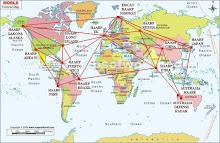
AN INDIAN FATHER PLEADS WITH HIS SON'S TEACHER TO RECOGNIZE THE BOY'S CULTURAL TRADITION AND PERSONAL ACCOMPLISHMENTS.
Dear teacher,
I would like to introduce you to my son, Wind-Wolf. He is probably what you would consider a typical Indian kid. He was born and raised on the reservation. He has black hair, dark brown eyes, an an olive complexion. And like so many Indian children his age, he is shy and quiet in the classroom. He is 5 years old, in kindergarten, and I can't understand why you have already labeled him a "slow learner."
At the age of 5, he has already been through quite an education compared with his peers in Western society. As his first introduction into this world, he was bonded to his mother and to the Mother Earth in a traditional native childbirth ceremony. And he has been continuously cared for by his mother, father, sister, cousins, aunts, uncles, grandparents, and extended tribal family since this ceremony.
From his mother's warm and loving arms, Wind-Wolf was placed in a secure and specially designed Indian baby basket. His father and the medicine elders conducted another ceremony with him that served to bond him with the essence of his genetic father, the Great Spirit, the Grandfather Sun, and the Grandmother Moon. This was all done in order to introduce him properly into the new and natural world, not the world of artificiality, and to protect his sensitive and delicate soul. It is our people's way of showing the newborn respect, ensuring that he starts his life on the path of spirituality.
The traditional Indian baby basket became his "turtle's shell" and served as the first seat for his classroom. He was strapped in for safety, protected from injury by the willow roots and hazel wood construction. The basket was made by a tribal elder who had gathered her materials with prayer and in a ceremonial way. It is the same kind of basket that our people have used for thousands of years. It is specially designed to provide the child with the kind of knowledge and experience he will need in order to survive in his culture and environment.
Wind-Wolf was strapped in snugly with a deliberate restriction upon his arms and legs. Although you in Western society may argue that such a method serves to hinder motor-skill developement and abstract reasoning, we believe it forces the child to first develop his intuitive faculties, rational intellect, symbolic thinking, and five senses. Wind-Wolf was with his mother constantly, closely bonded physically, as she carried him on her back or held him in front while breastfeeding. She carried him everywhere she went, and every night he slept with both parents. Because of this, Wind-Wolf's educational setting was not only a "secure" environment, but it was also very colorful, complicated, sensitive, and diverse. He has been with his mother at the ocean at daybreak when she made her prayers and gathered fresh seaweed from the rocks, he has sat with his uncles in a rowboat on the river while they fished with gill nets, and he has listened to elders as they told creation stories and animal legends and sang songs around the campfires.
He has attended the sacred and ancient White Deerskin Dance of his people and is well-acquainted with the cultures and languages of other tribes. He has been with his mother when she gathered herbs for healing and watched his tribal aunts and grandmothers gather and prepare tradtional foods such as acorn, smoked salmon, eel, and deer meat. He has played with abalone shells, pine nuts, iris grass string, and leather while watching the women make beaded jewelry and traditional native regalia. He has had many opportunities to watch his father, uncles,and ceremonial leaders use different kinds of colorful feathers and sing different kinds of songs while preparing for the sacred dances and rituals.
As he grew older, Wind-Wolf began to crawl out of the baby basket, develop his motor skills, and explore the world around him. When frightened or sleepy, he could always return to the basket, as a turtle withdraws into its shell. Such an inward journey allows one to reflect in privacy on what he has learned and to carry the new knowledge deeply into the unconscious and the soul. Shapes, sizes, colors, texture, sound, smell, feeling, taste, and the learning process are therefore functionallly integrated - the physical and spiritual, matter and energy, conscious and unconscious, individual and social.
This kind of learning goes beyond the basics of distinguishing the difference between rough and smooth, square and round, hard and soft, black and white, similarities and extremes.
For example, Wind-Wolf was with his mother in South Dakota while she danced for seven days straight in the hot sun, fasting, and piercing herself in the sacred Sun Dance Ceremony of a distant tribe. He has been doctored in a number of different healing ceremonies by medicine men and women from diverse places ranging from Alaska and Arizona to New York and California. He has been in more than 20 different sacred sweat-lodge rituals - used by native tribes to purify mind, body, and soul-since he was 3 years old, and he has already been exposed to many different religions of his racial brothers: Protestant, Catholic, Asian Buddhist, and Tibetan Lamaist.
It takes a long time to absorb and reflect on these kinds of experiences, so maybe that is why you think my Indian child is a slow learner. His aunts and grandmothers taught him to count and know his numbers while they sorted out the complex materials used to make the abstract designs in the native baskets. He listened to his mother count each and every bead and sort out numerically according to color while she painstakingly made complex beaded pelts and necklaces. He learned his basic numbers by helping his father count and sort the rocks for a medicine sweat, say, or 13 for the summer solstice ceremony. (The rocks are later heated and doused with water to create purifying steam.) And he was taught to learn mathematics by counting the sticks we use in our traditional native hand game. So I realize he may be slow in grasping the methods and tools that you are now using in your classroom, ones quite familiar to his white peers, but I hope you will be patient with him. It takes time to adjust to a new cultural system and learn new things.
He is not culturally "disadvantaged," but he is culturally "different." If you ask him how many months there are in a year, he will probably tell you 13. He will respond this way not because he doesn't know how to count properly, but because he has been taught by our traditional people that there are 13 full moons in a year according to the native tribal calendar and that there are really 13 planets in our solar system and 13 tail feathers on a perfectly balanced eagle, the most powerful kind of bird used in ceremony and healing.
But he also knows that some eagles may only have 12 tail feathers, or seven, that they do not all have the same number. He knows that the flicker has exactly 10 tail feathers; that they are red and black, representing the directions of east and west, life and death; and that this bird is considered a "fire" bird, a power used in native doctoring and healing. He can probably count more than 40 different kinds of birds, tell you and his peers what kind of bird each is and where it lives, the seasons in which it appears, and how it is used in a sacred ceremony. He may have trouble writing his name on a piece of paper, but he knows how to say it and many other things in several different Indian languages. He is not fluent yet because he is only 5 years old and required by law to attend your educational system, learn your language, your values, your ways of thinking, and your methods of teaching and learning.
So you see, all of these influences together make him somewhat shy and quiet- and perhaps "slow" according to your standards. But if Wind-Wolf was not prepared for his first tentative foray into your world, neither were you appreciative of his culture. On the first day of class, you had difficulty with his name. You wanted to call him Wind, insisting that Wolf somehow must be his middle name. The students in the class laughed at him, causing further embarrassment.
While you are trying to teach him your new methods, helping him learn new tools for self-discovery and adapt to his new learning environment, he may be looking out the window as if daydreaming. Why? Because he has been taught to watch and study the changes in nature. It is hard for him to make the appropriate psychic switch from the right to the left hemisphere of the brain when he sees the leaves turning bright colors, the geese heading south, and the squirrels scurrying around for nuts to get ready for a harsh winter. In his heart,in his young mind, and almost by instinct, he knows that this is the time of year he is supposed to be with his people gathering and preparing fish, deer meat, and native plants and herbs, and learning his assigned tasks in this role. He is caught between two worlds, torn by two distinct cultural systems.
Yesterday, for the third time in two weeks, he came home crying and said he wanted to have his hair cut. He said he doesn't have any friends at school because they make fun of his long hair. I tried to explain to him that in our culture, long hair is a sign of masculinity and balance and is a source of power. But he remained adamant in his position.
To make matters worse, he recently encountered his first harsh case of racism. Wind-Wolf had managed to adopt at least one good school friend. On the way home from school one day, he asked his new pal if he wanted to come home to play with him until supper. That was OK with Wind-Wolf's mother, who was walking with them. When they all got to the little friend's house, the two boys ran inside to ask permission while Wind-Wolf's mother waited. But the other boy's mother lashed out: "It is OK if you have to play with him at school, but we don't allow those kind of people in our house!" When my wife asked why not, the other boy's mother answered, "Because you are Indians, and we are white, and I don't want my kids growing up with your kind of people."
So now my young Indian child does not want to go to school anymore (even though we cut his hair). He feels that he does not belong. He is the only Indian child in your class, and he is well aware of this fact. Instead of being proud of his race, heritage, and culture, he feels ashamed. When he watches television, he asks why the white people hate us so much and always kill our people in the movies and why they take everything away from us. He asks why the other kids in school are not taught about the power, beauty, and essence of nature or provided with an opportunity to experience the world around them firsthand. He says he hates living in the city and that he misses his Indian cousins and friends. He asks why one young white girl at school who is his friend always tells him "I like you, Wind-Wolf, because you are a good Indian."
Now he refuses to sing his native songs, play with his Indian artifacts, learn his language, or participate in his sacred ceremonies. When I ask him to go to a powwow or help me with a sacred sweat-lodge ritual, he says no because "that's weird," and he doesn't want his friends at school to think he doesn't believe in God.
So, dear teacher, I want to introduce you to my son, Wind-Wolf, who is not really a "typical" little Indian kid after all. He stems from a long line of hereditary chiefs, medicine men and women, and ceremonial leaders whose accomplishments and unique forms of knowledge are still being studied and recorded in contemporary books. He has seven different tribal systems flowing through his blood; he is even part white. I want my child to succeed in school and in life. I don't want him to be a dropout or juvenile delinquent or to end up on drugs and alcohol because he is made to feel inferior or because of discrimination. I want him to be proud of his rich heritage and culture, and I would like him to develop the necessary capabilities to adapt to, and succeed in, both cultures. But I need your help.
What you say and what you do in the classroom, what you teach and how you teach it, and what you don't say and don't teach will have a significant effect on the potential success or failure of my child. Please remember that this is the primary year of his education and development. All I ask is that you work with me, not against me, to help educate my child in the best way. If you don't have the knowledge, preparation, experience, or training to effectively deal with culturally different children, I am willing to help you with the few resources I have, or direct you to such resources.
Millions of dollars have been appopriated by Congress and are being spent each year for "Indian Education." All you have to do is take advantage of it and encourage your school to make an effort to use it in the name of "equal education." My Indian child has a constitutional right to learn, retain and maintain his heritage and culture. By the same token, I strongly believe that non-Indian children also have a constitutional right to learn about our Native American heritage and culture because Indians play a significant part in the history of Western society. Until this reality is equally understood and applied in education as a whole, there will be a lot more schoolchildren in grades K-2 identifed as "slow learners."
My son is not an empty glass coming into your class to be filled. He is a full basket coming into a different environment and society with something special to share. Please let him share his knowledge, heritage, and culture with you and his peers.
Robert Lake (Medicine Grizzlybear) A member of the Seneca and Cherokee Indian Tribes.
From Teacher Magazine, September 1990
He was an associate professor at Gonzaga University's School of Education in Spokane, Washington; when this was written.
A special thank you goes out to my teacher and mentor Dr. Henrietta Mann (Full Blooded Southern Cheyenne)for a copy of this essay. Peace to you always.
AWAKEN TO PEACE AND LOVE
TARA











